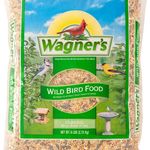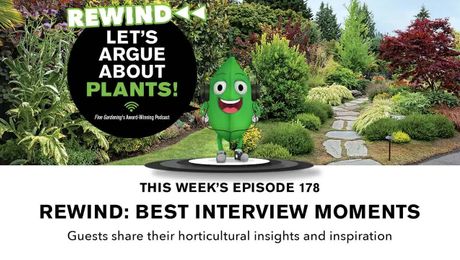
Barry Severn, who lives in the Toronto area (Zone 5), shared these portraits of small wildlife visitors in the garden. No matter how small your garden is or where it is located, you can make it a great habitat for insects like these.
 An elegant black wasp, maybe a spider hunter, on what looks to be the flowers of golden alexander (Zizia aurea, Zones 3–8).
An elegant black wasp, maybe a spider hunter, on what looks to be the flowers of golden alexander (Zizia aurea, Zones 3–8).
 A bumblebee on a zinnia (Zinnia elegans, annual).
A bumblebee on a zinnia (Zinnia elegans, annual).
 A red admiral butterfly on a buttonbush (Cephalanthus occidentalis, Zones 5–9).
A red admiral butterfly on a buttonbush (Cephalanthus occidentalis, Zones 5–9).
 Many bumblebees on showy goldenrod (Solidago speciosa, Zones 3–8). Goldenrod has a bad name because it blooms during hay fever season, but ragweed is the culprit behind all the sneezing. The species Solidago canadensis is quite weedy, but species such as showy and stiff goldenrods are well-behaved. And as you can see from this image, bees love them.
Many bumblebees on showy goldenrod (Solidago speciosa, Zones 3–8). Goldenrod has a bad name because it blooms during hay fever season, but ragweed is the culprit behind all the sneezing. The species Solidago canadensis is quite weedy, but species such as showy and stiff goldenrods are well-behaved. And as you can see from this image, bees love them.
 A red admiral on a purple coneflower (Echinacea purpurea, Zones 3–9).
A red admiral on a purple coneflower (Echinacea purpurea, Zones 3–9).
 A swallowtail butterfly nectaring on a purple coneflower.
A swallowtail butterfly nectaring on a purple coneflower.
 Monarch butterflies feed on a fall-blooming aster. Later-blooming plants are important food sources for monarchs as they migrate south to overwinter in Mexico.
Monarch butterflies feed on a fall-blooming aster. Later-blooming plants are important food sources for monarchs as they migrate south to overwinter in Mexico.
 A tiny hover fly. These little flies are harmless and great pollinators, but their black-and-yellow coloration makes them look like a stinging wasp to scare off potential predators. The enormous eyes are one giveaway that it is a fly, not a wasp or bee.
A tiny hover fly. These little flies are harmless and great pollinators, but their black-and-yellow coloration makes them look like a stinging wasp to scare off potential predators. The enormous eyes are one giveaway that it is a fly, not a wasp or bee.
 A wasp resting on a corn leaf.
A wasp resting on a corn leaf.
 A wool carder bee on a late-flowering low sedum.
A wool carder bee on a late-flowering low sedum.
Have a garden you’d like to share?
Have photos to share? We’d love to see your garden, a particular collection of plants you love, or a wonderful garden you had the chance to visit!
To submit, send 5-10 photos to [email protected] along with some information about the plants in the pictures and where you took the photos. We’d love to hear where you are located, how long you’ve been gardening, successes you are proud of, failures you learned from, hopes for the future, favorite plants, or funny stories from your garden.
If you want to send photos in separate emails to the GPOD email box that is just fine.
Have a mobile phone? Tag your photos on Facebook, Instagram or Twitter with #FineGardening!
You don’t have to be a professional garden photographer – check out our garden photography tips!
Do you receive the GPOD by email yet? Sign up here.
Fine Gardening Recommended Products

The Nature of Oaks: The Rich Ecology of Our Most Essential Native Trees
Fine Gardening receives a commission for items purchased through links on this site, including Amazon Associates and other affiliate advertising programs.

Wagner's 52003 Classic Blend Wild Bird Food, 6-Pound Bag
Fine Gardening receives a commission for items purchased through links on this site, including Amazon Associates and other affiliate advertising programs.

Planting in a Post-Wild World: Designing Plant Communities for Resilient Landscapes
Fine Gardening receives a commission for items purchased through links on this site, including Amazon Associates and other affiliate advertising programs.

















Comments
Absolutely fabulous pics!
Impressive and beautiful photography! Thank you for the information.
Was so happy to see your photos. I wish I had the equipment to take such lovely nature photos. My daughter-in-law is a photographer, so she said she would come over and photograph my spring garden. I only hope she can get as beautiful photos as you have posted here. Thanks for all the beauty you added to our day!
Great photography! Informative and beautiful. I love such detailed garden insect photography. I've tried and most often they fly off before I snap a photo. So nice to see these, and learn their names.
Incredible pictures, and great information! Just purchased a mason bee house from Etsy - mason bees are very docile, and quite sociable - they visit us during happy hour in our Japanese garden. They hover, looking us over. My husband says they are taking pictures.
I love this post. Thank you for planting for pollinators!
Beautiful photos. I love close ups in the garden. Makes me anxious for warmer days here in MN. What camera and settings did you use?
Olympus and Canon. But any real camera. Probably some of the recent phones. And a macros lens helps.
Amazing photos. Thanks for the post.
Wonderful - makes me miss the very large, mature lavenders in my NJ garden. The bumblebees especially loved them and filled the front border walkway with their humming.
Beautiful photos. I just saw our first butterfly of the year here in central Michigan, also a zone 5. Exciting times ahead.
I enjoyed your photos very much. Thank you for sharing with us!
Great Pics. I would add that flies such as the hover fly have SHORT antennae which is another way to distinguish them from wasps. Also wasps have very skinny waist. Appreciate your pics . Thanks
Log in or create an account to post a comment.
Sign up Log in